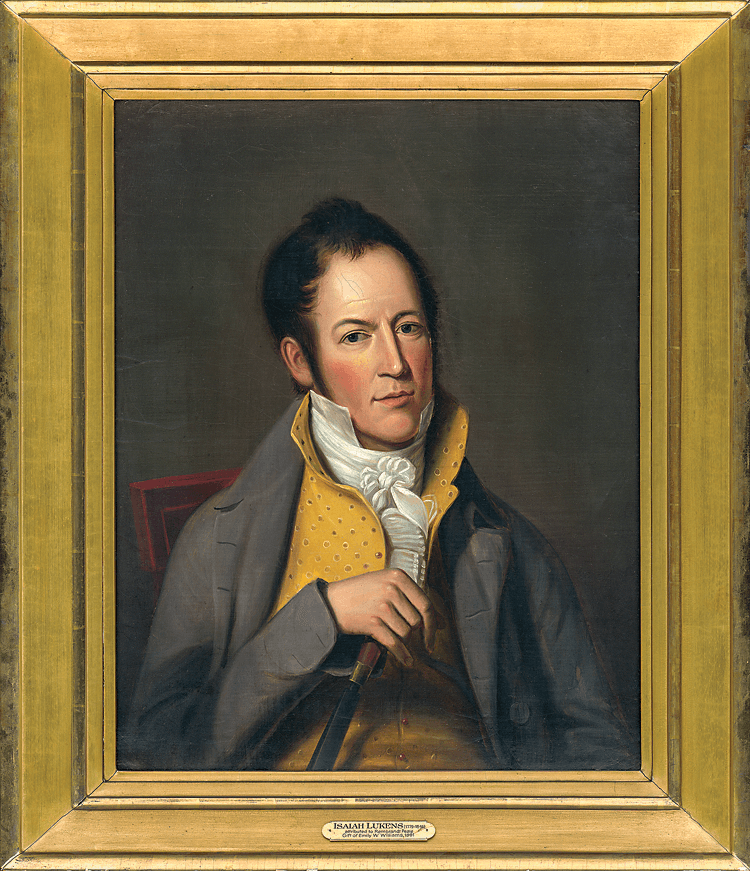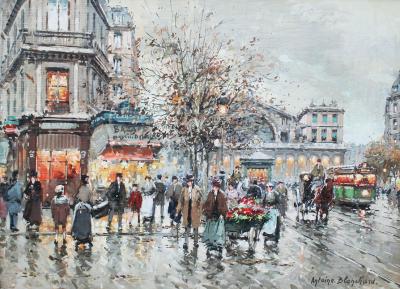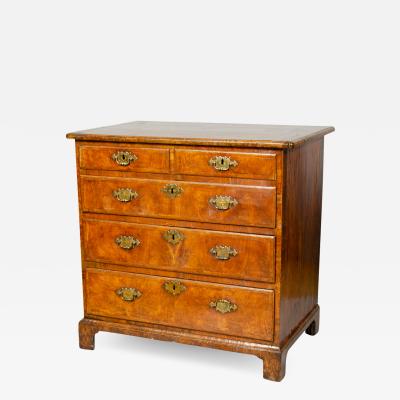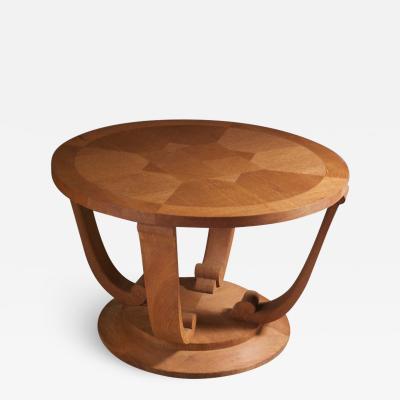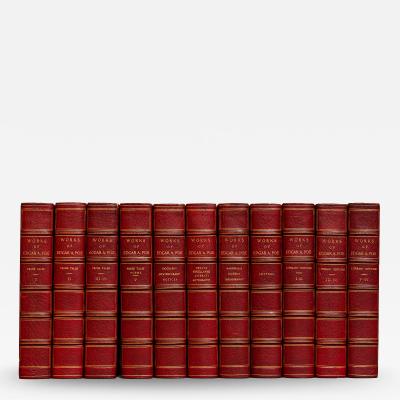The Athenaeum of Philadelphia
Celebrating 200 Years
Toward the end of 1813, a small group of gentlemen in Philadelphia saw the need for a place where they could gather to read periodicals and works on politics and the natural sciences. The group soon realized that to finance their venture they had to expand their ranks and formally organize. The Athenaeum Reading Room opened its door on March 7, 1814, in two rooms over Anthony Finley’s bookshop at Fourth and Chestnut Streets. The founders applied for and received a charter from the Supreme Court of Pennsylvania to procure and collect “newspapers of different states and countries, pamphlets, books, maps, charts and…historical and other monuments, connected with the history and antiquities of America, and the useful arts, and generally to disseminate useful knowledge.” 1
Early on, the members explored the possibility of acquiring a site and erecting a building, but renting space remained a wiser choice and, after a brief move to Carpenters’ Court, they leased rooms in Philosophical Hall from artist Thomas Sully (1783–1872). As the collections grew so did a revival of interest in constructing a building, but the financial woes of the 1830s dampened enthusiasm for the project. Finally, at the end of March 1843, the building committee approved purchase of a long narrow lot on Sixth Street, facing Washington Square, and requested proposals from several architects, including John Haviland (1792–1852), Napoleon Le Brun (1821–1901), and John Notman (1810–1865). Notman won the competition in 1845 with a plain design reminiscent of a London club that was, nonetheless, stylistically bold and introduced the Italian Renaissance Revival to the United States (Fig. 1). The first and third floors were dedicated to offices and rental spaces, with the main floor on the second level reserved for the use of the Athenaeum. To keep construction costs in line, Notman substituted red-brown sandstone for the marble in the specifications, another visual departure from the redbrick streetscapes of Philadelphia.
![Fig. 2: At the piano nobile level of a grand, four-story staircase, is the Members’ Reading room, which measures 37 feet wide, 65 feet long, and 24 feet high. The woodwork is oak grained, and the pillars, columns, and pilasters are simulated Sienna marble. The three gasoliers, probably made by Cornelius & Baker (1835–1869), the largest lighting manufacturer in the United States by 1845, are original to the building. They were electrified in 1923 and the glass shades replaced in the 1970s. An 1867 terrestrial globe, “…[c]ompiled from the latest & most authentic Sources…”, and made by Thomas Malby & Son, London, has pride of place at the center of the room. Photography by Tom Crane, 2006.](../sites/uploads/0022.png)
- Fig. 2: At the piano nobile level of a grand, four-story staircase, is the Members’ Reading room, which measures 37 feet wide, 65 feet long, and 24 feet high. The woodwork is oak grained, and the pillars, columns, and pilasters are simulated Sienna marble. The three gasoliers, probably made by Cornelius & Baker (1835–1869), the largest lighting manufacturer in the United States by 1845, are original to the building. They were electrified in 1923 and the glass shades replaced in the 1970s. An 1867 terrestrial globe, “…[c]ompiled from the latest & most authentic Sources…”, and made by Thomas Malby & Son, London, has pride of place at the center of the room. Photography by Tom Crane, 2006.
Today, the Athenaeum is the sole occupant of this National Historic Landmark building on Washington Square. First-time visitors typically exclaim as they climb the Grand Stair and glimpse the Reading Room (Fig. 2). Notman positioned the stair in the center of the building and divided the space on the piano nobile into three rooms: the Reading Room, the News Room, and the Chess Room. Woodwork in the Reading Room is oak grained, and the pillars, columns and pilasters simulate Sienna marble. Much of the furniture is original, as are the three brass gasoliers. Although unlabeled and unsigned, they were most likely made by Cornelius & Baker, who produced fixtures for the House of Representatives and Senate in Washington, D.C. and the academies of music in Philadelphia, Brooklyn, and Boston.2
An 1867 globe by Thomas Malby & Son of London has a prominent position in the Reading Room, which houses both a portion of the historic book collection as well as a circulating collection of contemporary periodicals and books. As a special collections library with a concentration in architecture and decorative arts, the Athenaeum owns a significant collection of trade catalogues, pattern books, and periodicals documenting interior design, in addition to an extensive reference collection of directories, bibliographies, monographs, manuscripts and archives of architectural firms, stained glass studios, and decorative painters.3
The News Room, now the Henry Paul Busch Reading Room, is striking for its grained pilasters and woodwork. Among its furnishings is a circa-1840 tall-case clock that reaches fourteen feet in height. Its maker, Isaiah Lukens (1779–1846), was known for his work on tower clocks, including that of Independence Hall, Philadelphia’s State House. A portrait of Lukens, attributed to a member of the Peale family, hangs in the same room (Fig. 3). He was the son of Horsham, Pennsylvania, farmer-turned clockmaker Seneca Lukens (1751–1829); the Athenaeum also owns an 1828 tall case clock made by Seneca for his daughter Tabitha. The Busch Room serves many functions but its primary users are those who come to the Athenaeum to undertake research and consult items in the collections, including the rare book collection.

- Fig. 5: The Philadelphia circa-1800 Federal bookcase in the Joseph N. Du Barry, IV, Conference Room was a 1978 gift from Mr. and Mrs. Peyton R. Biddle in memory of Francis R. Packard. At the lower right of the bookcase is a portrait attributed to the School of Thomas Sully of Henry Bird (1803–1864), the Athenaeum librarian (1859–1864); gift of Eleanor Bird Light (2002). The table was purchased from the shop of Anthony G. Quervelle in 1850 by Charles L. Pearson for “Glencairn,” a Trenton, New Jersey, house designed by John Notman. Gift of Messrs. Robert and George Pearson (1987). On the table are two lidded elliptic silver vegetable dishes from the Chauncey Table Service of 1825–1840, by Thomas C. Fletcher (1787–1866) and Sidney Gardiner (1727–1827), silversmiths, who relocated their Boston firm to Philadelphia in 1811. Charles Chauncey (1777–1849) was a Philadelphia lawyer who represented Fletcher and Gardiner in legal matters in the 1820s and 1830s. The silver service was a gift of Mary Radclyffe Furness Savage (1993). Photography by Jim Carroll.

- Fig. 6: John Neagle (1796–1865), Thomas Ustick Walter, 1835. Oil on canvas, 25 x 21 inches. Purchase (1984). Walter began his architectural career as an apprentice to William Strickland (1788–1854) but soon established his reputation with the 1833 design of Founder’s Hall at Girard College, Philadelphia. John Neagle listed his name as a portrait painter in an 1817 Philadelphia directory and in 1826 married Thomas Sully’s stepdaughter. He was active at the Pennsylvania Academy and in the Artists’ Fund Society. Commissioned by Walter to paint his portrait in 1835, Neagle included a portion of a fluted column from Founder’s Hall to the sitter’s left.
On the north side of the building, tucked between the two grand rooms on the piano nobile, is a space identified on Notman’s plan as the Chess Room, where mid-nineteenth-century Philadelphia gentlemen came to play chess or be instructed in the game. Some years after the death of George Allen (1808–1876), professor of Greek at the University of Pennsylvania and a chess enthusiast, Athenaeum stockholders purchased his collection of books, manuscripts, and prints, which ranked as one of the finest in the country. Allen’s collection and bookcase with its fanciful chess-themed cornice were presented to the Athenaeum in 1894. The books and papers are now in a temperature and humidity controlled vault but the bookcase is still in place as a reminder of the room’s history.
The Athenaeum’s early association with Philadelphia’s French émigré community also led to acquisition of books, paintings, sculpture and furniture with a French connection. A labeled pier table, circa 1825–1830 (Fig. 4), by cabinetmaker Anthony G. Quervelle (1789–1856), features decorative elements believed to have been derived from George Smith’s 1826 Cabinet-Maker and Upholsterer’s Guide.4
The collections of the Athenaeum include a portion of a silver dinner service made by Thomas Fletcher and Sidney Gardiner for founder Charles Chauncey (1777–1849), occasionally on display in the Joseph N. Du Barry, IV, Conference Room (Fig. 5). An associated collection of Fletcher family papers is in the Athenaeum’s manuscript collection. It is this connection between objects and documentation that makes the Athenaeum’s holdings so valuable to students and scholars as well as the casual visitor.
In the last quarter century the Athenaeum initiated multiple projects to further realize the founders’ goal of collecting in the “useful arts” (architecture and design) and disseminating “useful knowledge.” Its active collection of records from the offices of Philadelphia architects has established the institution as an important repository and resource for information on this subject. In 1983, the Athenaeum purchased five hundred drawings and thirty thousand pages of manuscript by architect Thomas U. Walter (1804–1887), and the following year, purchased a portrait of Walter painted in 1835 by John Neagle (Fig. 6), who established his reputation ten years later with a full-length portrait of a blacksmith, Pat Lyon at the Forge (Pennsylvania Academy of the Fine Arts).5 The Walter collection includes his proposals for the White House and drawings for Nicholas Biddle’s (1786–1844) mansion, “Andalusia,” and over one hundred drawings of the United States Capitol (Fig. 7). This purchase and others have made the Athenaeum nationally significant as a repository of architectural records. Through the online presence of the American Architects & Buildings Project (AAB), administered by the Athenaeum and an example of public, private and academic cooperation, historical and architectural information is available for over 250,000 structures in the United States (www.AmericanBuildings.org).

- Fig. 7: Thomas Ustick Walter (1804–1887), Design for the Extension and New Dome of the United States Capitol, Washington, D.C., 1855. Ink and watercolor, 22 x 42½ inches Thomas U. Walter Collection; purchase (1982). In 1851, Walter was appointed government architect in Washington, D.C., where he produced his most famous work, the dome of the United States Capitol. The Athenaeum owns the Walter manuscripts and over five hundred drawings.
Another collaborative Athenaeum venture—the Greater Philadelphia GeoHistory Network (www.PhilaGeoHistory.org)—established in 2005 with a grant from the Andrew W. Mellon Foundation, includes aerial photographs, city and county street maps, city directories, fire insurance atlases and industrial site surveys. Selected historic maps and aerial photographs, mixed with current data, are available in a Google Maps viewer. Scanning oversize maps, fragile materials and historic documents was done in-house at the Regional Digital Imaging Center (RDIC).
2014 will be a year of celebration, including the exhibition Useful Arts and Useful Knowledge, which runs through May 17, 2014 and showcases the founding of the Athenaeum. The exhibition Treasures of the Athenaeum: 200 Years of Collecting, runs from September 12 through November 15, 2014. A complete schedule of events is available at www.PhilaAthenaeum.org.
Maria M. Thompson is an architectural historian and board member of the Athenaeum of Philadelphia.
All images courtesy of the Athenaeum of Philadelphia.
This article was originally published in the Summer 2014 issue of Antiques & Fine Art magazine, a digitized version of which is available on afamag.com. InCollect.com is a division of Antiques & Fine Art, AFAnews, and AFA Publishing.
2. David A. Hanks, “Cornelius & Baker (1835–1869)” in Philadelphia: Three Centuries of American Art (Phila: Philadelphia Museum of Art, 1976), 334–335.
3. For a more comprehensive description of these collections see Architectural Collections: The Athenaeum of Philadelphia (Phila: The Athenaeum of Philadelphia, 1990) or visit www.PhilaAthenaeum.org.
4. Robert C. Smith, “Philadelphia Empire furniture by Antoine Gabriel Quervelle,” The Magazine Antiques (September 1964): 304–309.
5. Dorinda Evans, “John Neagle (1796–1865)” in Philadelphia: Three Centuries of American Art (Phila: Philadelphia Museum of Art, 1976), 278–280.
















